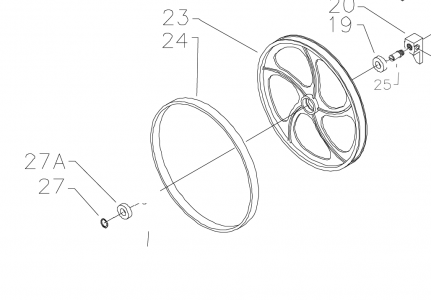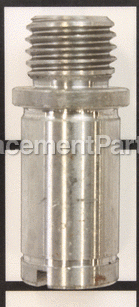- Joined
- May 2, 2022
- Messages
- 27
Hello,
sorry about the wall of words, I don't think I can make it smaller, although not complicated to understand.
Background:
I have a bandsaw that needs bearing replacement. the guy I bought it from told me it was replaced only 5 years ago, but Both bearings are bad when I brought it home suspecting poor quality bearings or poor installation. They are 6003 bearings. I want to upgrade to seal bearings from shielded. I have tried a couple of trial and error methods to get this to work Without success.
parts
The wheel ( part 23) is made of aluminum alloy. Bearings ( part 19 and 27 A) are 6003. Parts 25 is a shaft ( not keyed, but friction fit) that is 17 mm in diameter ( unverified). As you can see from the picture, the shaft has a stop in the back for the bearing. I also don't have an inside micrometre to measure the Exact bearing diameter. The shaft is 17.05 mm I think, But this could be wrong, as my digital CalPERS are cheap.)
reassembly installation procedure, deduced:
I want to achieve an easy slip fit Using temperature differential for two reasons. The first has to do with Not able to swing a hammer anymore With a lot of force. The second, is that it seems to be a two-step process as the shaft if driven last with a hydraulicpress or mallet will be pushing on the inner race while the outer race is also under force, damaging the bearing. My hypothesis is this is what happens five years ago.
My current attempts and/or strategies.
Please let me know how you think I should proceed. this is a real pain.
thanks


sorry about the wall of words, I don't think I can make it smaller, although not complicated to understand.
Background:
I have a bandsaw that needs bearing replacement. the guy I bought it from told me it was replaced only 5 years ago, but Both bearings are bad when I brought it home suspecting poor quality bearings or poor installation. They are 6003 bearings. I want to upgrade to seal bearings from shielded. I have tried a couple of trial and error methods to get this to work Without success.
parts
The wheel ( part 23) is made of aluminum alloy. Bearings ( part 19 and 27 A) are 6003. Parts 25 is a shaft ( not keyed, but friction fit) that is 17 mm in diameter ( unverified). As you can see from the picture, the shaft has a stop in the back for the bearing. I also don't have an inside micrometre to measure the Exact bearing diameter. The shaft is 17.05 mm I think, But this could be wrong, as my digital CalPERS are cheap.)
reassembly installation procedure, deduced:
- install bearings in wheel. Achieved with a small toaster oven at 200°F, as wheels are made of aluminum. Maximum recommendation for bearings. shaft at room temperature.
- part 25 must be slipped in through the back and not the front due to the bearing stop near the threads.
I want to achieve an easy slip fit Using temperature differential for two reasons. The first has to do with Not able to swing a hammer anymore With a lot of force. The second, is that it seems to be a two-step process as the shaft if driven last with a hydraulicpress or mallet will be pushing on the inner race while the outer race is also under force, damaging the bearing. My hypothesis is this is what happens five years ago.
My current attempts and/or strategies.
- ( failed Shaft/ success bearings in wheel, 310°F differential). the shaft and wheel are inserted in the oven together heated to 200°F. the shaft was cooled using dry ice is 109°F. I did not attempt to hammer it in, but tried placing. this may have been a mistake. two step process.
- ( Not attempted, 560°F differential, unknown if possible). I can replace the two bearings with high temperature steel shielded bearings which are much worse in performance. more expensive bearings at $15 a piece. I can heat to 450°F and drop in a dry ice shaft. I don't like this as the tire will need replacing every time this is performed. this is very difficult to remove without destroying. I'm assuming the bearing can take the 500°F and not just the grease which might be wrong. Making this an expensive bearing placement, Done often). I can't find a seal bearing for 6003 high-temperature steel[ opinion: bad solution, But may B only option]
- [not attempted, 360°F differential. bring the wheel my local nitrogen supplier in Toronto Canada. I called a guy and ask if I bring the one wheel. I told him it was 15.5 mm rather than 17 mm by mistake. He said this would fail and said don't bother coming.
- [ not attempted, 510°F differential] I could go back to my same nitrogen supplier and bring my small toaster oven ha ha. Or my heat gun. He might say no. I don't know if this would work
- different installation method not considered.
Please let me know how you think I should proceed. this is a real pain.
thanks


Last edited:

